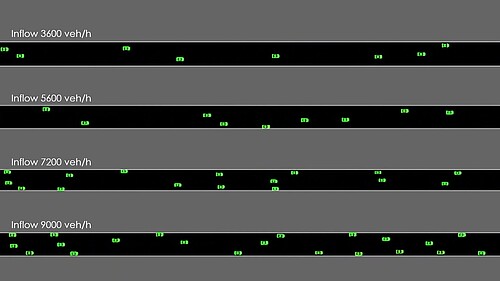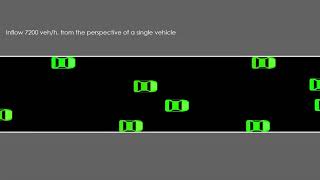Video Playlist 4. Collaborative multiagent decision making for lane-free autonomous driving
The videos included in this playlist are part of the results discussed in the paper titled "Collaborative multiagent decision making for lane-free autonomous driving". In this work, a lane-free highway scenario is formulated as a multiagent collaboration problem and is represented via a coordination graph, thus decomposing the problem with local utility functions, based on the interactions between vehicles. We provide a coordinated multiagent policy designed to promote collision avoidance while each individual vehicle targets its desired speed.
Collaborative policy for various inflow rates
In this video, we illustrate simulations for various constant inflow rates (demands) ranging from 3600 veh/h to 9000 veh/h, for a highway of 10.2m width. This would correspond to a conventional 3-lane highway, where a demand of 9000 veh/h is well beyond the capacity of lane-based traffic. Each vehicle possesses a desired speed within the range [25,35]m/s, and as expected, we observe fewer overtakings (overtakings occur since vehicles target their respective desired speed) as the demand increases, due to the higher density of vehicles. Specifically, vehicles located in regions with higher vehicle density tend to maintain similar speeds for safety, and perform overtakings more cautiously. For further discussion, check the above-mentioned paper.

Collaborative policy from a CAV's perspective
In this video, we illustrate a simulation on the same highway as above, and for inflow rate of 7200 veh/h, focusing on a single vehicle with relatively high desired speed, so as to observe a more interesting behavior, showcasing how the collaborative policy handles overtakes. The vehicle in focus is adjusting its lateral position appropriately to overtake, while maintaining safe distances from its surroundings. At a given point (0:07), we can observe that a nearby vehicle is overtaking at the same time, an operation that is possible, since the vehicles are moving in a lane-free traffic environment, and online coordination can enable such collaborative maneuvers. For further discussion, check the afore-mentioned paper.

